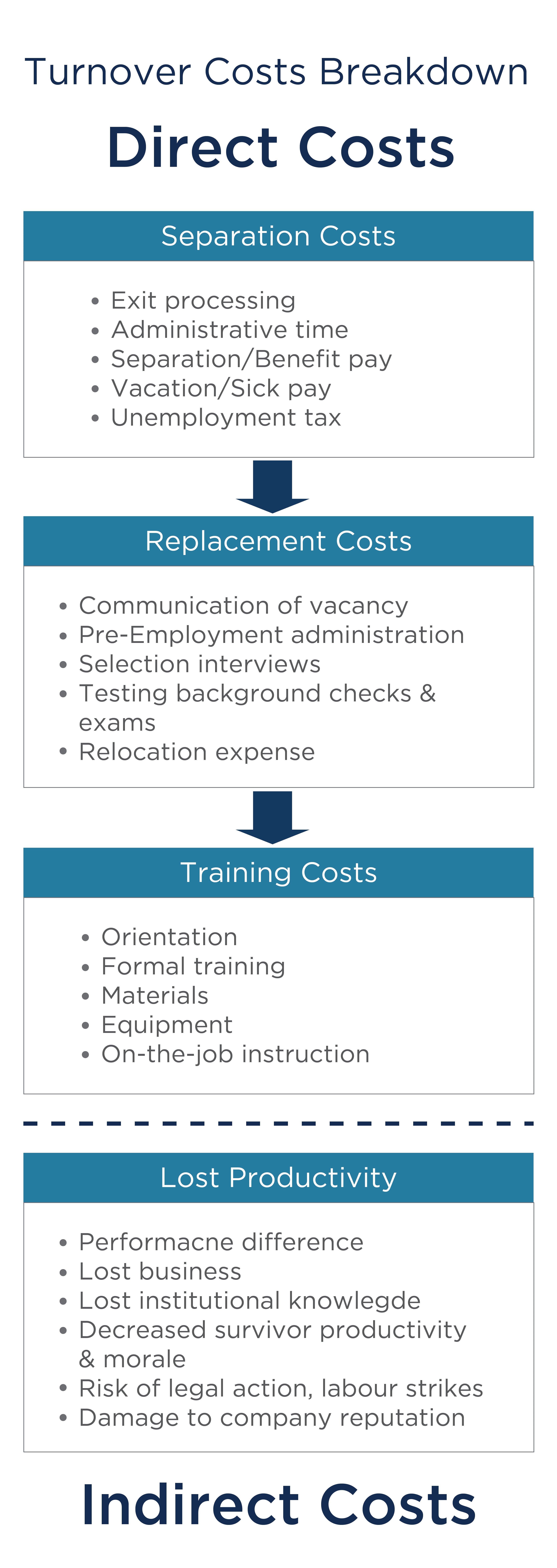In the USA, voluntary staff turnover costs the economy $536 billion: that’s $15,000 per employee on average. In Australia, staff turnover costs $3.8 billion in lost productivity and $385 million is attributed to avoidable recruitment costs. It’s a frightful thought when you start thinking about what your organisationorganization spends to replace staff and how your bottom line is suffering. 
Turnover costs breakdown (Credit: Hubspot – US)
What makes employees stay?
Culture Amp research suggests that the top three drivers of employees commitment to stay are:
- Alignment
- Leadership
- Learning and development
They say, “Even good managers are likely to struggle to retain key employees and manage team retention rates if these factors are not looked after.”
Six strategies to retain staff
Considering the cost of replacing a staff member, any organisationorganization looking to protect their bottom line needs to motivate, develop and retain their people. From a person’s first face-to-face interview, through to their onboarding, ongoing development and overall experience, here are six strategies to retain employees:
1. Hire for attitude
A candidate is sitting opposite you at their face-to-face interview. As they talk through their experience, start thinking, “How will this person develop in line with my organisationorganization’s five-year plan?” Aside from their current skill set, do they have the potential to move into succession roles? According to SEEK, “A strong applicant will showcase how they are right for the job from the moment they commence the application process.” The questions they ask during the interview will show their eagerness for the role. This is a great sign – it helps determine if they are the right person and their willingness to progress.
“A strong applicant will showcase how they are right for the job from the moment they commence the application process.”
2. Conduct interviews with consistency
A concrete selection process can make a great difference to who you let in the door. Says SEEK, “Ensure that candidates are selected fairly against the same criteria and that they are invited to provide feedback at various recruitment touchpoints.” Hiring managers should be trained in the recruitment process and know what signs to look for. Nowadays, pre-screening tools like video and artificial intelligence recruiting software allow recruiters and people leaders to efficiently screen and interview candidates.
3. Give an honest representation of the role and the company
A recent webinar by the Institute of Managers and Leaders raised a point that some may think of as obvious – hiring managers need to be present at interviews. After all, the candidate will report into them and will need to align their own goals with the organisationorganization’s deliverables. Hiring managers should also act as ‘talent beacons’, selling the organisationalorganizational vision and values. And equally important – is transparency about the role and the company. If the role involves meeting a number of targets or KPIs per month, disclose it upfront. Share organisationalorganizational goals with the candidate, so they get an understanding of how their role will contribute to the company’s overall success.
“Hiring managers should also act as ‘talent beacons’, selling the organisationalorganizational vision and values.”
4. Provide a great onboarding experience
According to Harvard Business Review, an alarming 33% of new employees look for a new job within their first six months of employment. Another 23% of them leave before their one-year anniversary. Therefore, it’s crucial to offer a consistent and seamless onboarding experience.
A key driver of employee retention is continuous development. According to Deloitte, “Employees and organisationsorganizations expect continuous learning. New performance management practices (and tools) facilitate regular discussions about capabilities and skills, helping employees learn where to focus and what learning to adopt.” Deloitte have moved away from traditional performance reviews, and instead are using every day performance conversations as part of business-as-usual activities. This approach enables employees to see how they’re achieving their current goals, identify areas for further development, and how they’re tracking for future roles.
5. Empower people leaders to develop their people
Development has a great impact on employee retention. Culture Amp states that “People are more likely to leave companies that don’t provide them with good development opportunities and leadership.” Managers should be empowered to coach and promote people in their teams. At the same time, Managers should be proactively involved in development conversations with individuals, coaching and motivating them along the way. As summed up by Culture Amp, “Having a great manager often feels like having a good coach. A coach looks out for their team members, works with people to cultivate skills and reach goals, and celebrates success together.”
“Having a great manager often feels like having a good coach. A coach looks out for their team members, works with people to cultivate skills and reach goals, and celebrates success together.”
6. Offer a great employee experience
If you’ve ticked all of the boxes above, turn to your day-to-day offering. Are you providing a great employee experience? What drives people to come in every day to work for your organisationorganization? Here are some factors to think about:
- Flexible/remote working – do you offer it? If not, how can you accommodate specific employee needs?
- Volunteer days off? OrganisationsOrganizations that demonstrate social responsibility rank highly for today’s employees
- Health and wellbeing – show you care. Are you offering gym memberships, standing desks and wellbeing seminars?
- Does your organisationorganization offer a good culture? What can you do better?
- Surprise and delight – is there spontaneous recognition of individuals for a job well done, like movie tickets or dinner vouchers?
- Good IT is mandatory (laptop, internet connectivity) to ensure employees are productive and not frustrated. They are the basics but very important.
Fresh insights for HR
Stay up to date with HR trends, tips and more when you sign up for our industry newsletter






